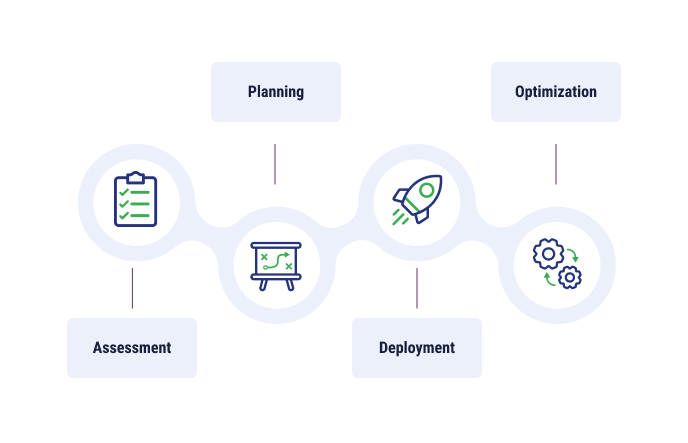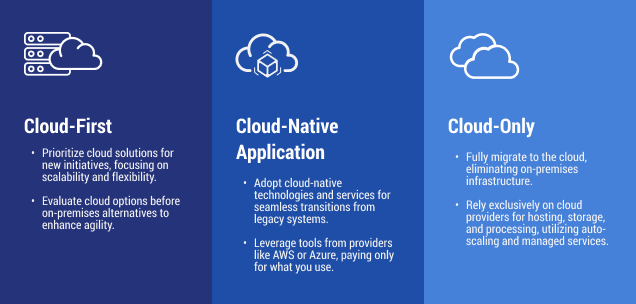
Businesses are embracing multicloud and hybrid cloud environments in larger numbers every year. According to the 2024 State of the Cloud report, 89% of worldwide cloud decision-makers report that their organizations are employing a multicloud approach, 73% of which are hybrid cloud environments. Most respondents in both enterprise and SMB organizations say that their biggest challenge in cloud migration is understanding app dependencies, followed by assessing the costs of on-premises vs. cloud infrastructure and assessing the technical feasibility of migrating to public cloud.
Although more companies have added cloud environments to their infrastructure, many have done so in a haphazard fashion by addressing needs as they’re realized rather than using a pre-planned strategy for cloud adoption. Those who take a piece-by-piece adoption approach are more prone to cloud sprawl, which can lead to:
- Unnecessary complexity
- Cloud budget waste
- Compliance issues
- Security gaps
- Reduced agility
To promote IT modernization and prevent future headaches associated with cloud sprawl, IT leaders should take time to develop and deploy a structured plan that will serve as a guide for implementing and governing the cloud and its resources across their organization. With that, let’s explore what exactly a cloud adoption strategy is, what challenges to keep in mind, and what to include throughout the planning process.
What is a Cloud Adoption Strategy?
A cloud adoption strategy is a plan that details the reason and approach an organization will take when moving to the cloud. This could include best practices, business goals, and the steps a business needs to take to achieve cloud adoption, defined by Amazon Web Services (AWS) as envision, align, launch, and scale in the AWS cloud adoption framework.
On a high level overview, a cloud adoption strategy is the foundation for deploying and governing the use of the cloud across the entire organization, and should be created in conjunction with a cloud operating model.
Additionally, it should help the IT organization communicate the importance of the cloud to the rest of the organization and explain how existing workloads and data can be moved to improve efficiency, modernize systems, boost automation and integration capabilities, and more.
Why is Cloud Adoption Important?
One of the biggest challenges businesses face in cloud migration is identifying app dependencies, it’s important to understand the current and future cloud environment before applying a cloud adoption strategy. Businesses should be able to clearly define their objectives for cloud migration and evaluate the factors needed to find success with cloud adoption.
Organizations may choose a cloud adoption strategy to achieve the following:
- Improve scalability
- Provide better accessibility to data and applications
- Offer new opportunities for collaboration
- Save on capital expenditure costs
- Improve efficiency through automation and boosted performance
- Incorporate cloud-based services and innovate using newer technologies
Some organizations may also need to consider the following factors while determining if cloud adoption is right for them:
- Migration complexity that may require a phased approach
- Internal Skill gaps that may hinder smooth cloud adoption
- Existing IT infrastructure and data and what may need to change to improve the success of cloud migration
- How cloud migration will impact the business before, during, and after the project
4 Key Steps to a Cloud Adoption Strategy
By assessing and planning a cloud adoption before deployment, and monitoring after migration is complete, businesses can ensure they have a more successful cloud adoption experience. Here’s what you should include in your strategy.

Assessment
Start by evaluating your existing IT infrastructure. This can include applications, data storage, and any app dependencies that need to be considered when moving to a new environment. Analyze the level of complexity and compliance needs associated with moving to the cloud, and understand any security settings that may need to change.
Planning
Your cloud adoption plan should include a definition of your objectives, identification of business factors, and creation of a cloud migration framework. Whether you’re looking to enhance data security, improve collaboration across teams, or improve business operations in some way, define your objectives early so you know how to measure success and prioritize phases.
Next, go beyond the technical considerations and evaluate the business factors relevant to cloud migration. What in-house skill sets can you draw on for cloud adoption, and where might you need to hire outside help? If your organization needs to meet certain compliance standards, one cloud provider may be more appropriate than another. You may also want to develop a data security plan to address concerns about ransomware and other cybersecurity risks. You may want to conduct a cloud adoption readiness assessment.
From there, develop a tailored cloud adoption framework that defines the migration approach you will take, the tools you will use, the timeline in which certain phases will take place, and the metrics you will use to measure success.
Deployment
After you’ve created a well-defined framework, it’s time to choose an appropriate deployment model. Each model – public cloud, private cloud, and hybrid cloud – offers unique benefits and considerations, so it’s essential to understand which one aligns best with your organization’s needs, security requirements, and budget.
- A private cloud offers dedicated resources and enhanced control, making it ideal for organizations with strict security and compliance requirements
- Public clouds, provided by third-party vendors, offer scalability and cost-effectiveness, making them suitable for businesses with fluctuating workloads
- The hybrid cloud model combines elements of both private and public clouds, allowing organizations to leverage the benefits of each. Hybrid cloud adoption enables businesses to keep sensitive data on-premises while taking advantage of the public cloud’s scalability for less critical workloads
Within the deployment model you choose, you’ll migrate relevant workloads to the cloud environment with the chosen approach, use identified tools, and adhere to established deadlines. Some applications and data may be migrated before other workloads based on dependencies and complexity. Organizations may also want to start with lower-risk applications to test the effectiveness of the approach before moving business-critical workloads.
Optimization
Because cloud optimization is an ongoing process, and not a one-time task, businesses should plan to continuously monitor their cloud environment to identify opportunities for better performance, stronger security, and improved cost efficiencies. New cloud services will also emerge in the months and years after a cloud migration. Businesses should have in-house or outside experts with a finger on the pulse of the latest technologies to continue to enhance cloud environments.
Cloud Adoption Strategy & Deployment Challenges
Building a cloud adoption strategy can come with complications and challenges. Being aware of what your business might encounter, and planning for it along the way, will help your cloud adoption strategy go smoothly.
Security
Cloud computing comes with a lot of advantages, but the added ease of access and flexibility also means additional endpoints and vulnerabilities that can be used to infiltrate your business. To address these security concerns, it’s pertinent to understand the shared responsibility model in cloud security. While cloud platforms implement detailed security measures and adhere to strict regulations, the responsibility for cloud data protection is shared between the provider and the customer. Cloud providers typically secure the infrastructure, while customers are responsible for securing their data, applications, and access management. This model emphasizes that organizations must actively participate in their cloud security strategy, implementing measures such as encryption, access controls, and regular security audits.
By understanding how cloud environments work and clearly defining security responsibilities, you can significantly improve your organization’s overall security posture and better protect assets in the cloud.
Vendors
Working with several vendors can help your organization get the exact cloud configuration you need, but it also opens the door to added complexity. Using more than one cloud provider can complicate billing, compliance, and application and workload management across all environments, not to mention potential security concerns. The better visibility you have across vendors, the less it will be a problem to operate between them.
Compliance
Compliance concerns vary by industry and region but can include data protection needs (GDPR and the like), specific procedures for sensitive financial or medical data, or complying with regulations set by an industry agency or governmental body. Best practices can be even harder to establish when compliance needs to be met in different ways on different cloud platforms.
ROI
Leadership can be slow to greenlight a project if proving the ROI is difficult. While cloud adoption can save money on capital expenditures, like hardware, physical data center rentals, utilities, and so on, the initial migration process can feel like extra spending to stakeholders who don’t see the bigger picture of a model that prioritizes automation and in-house resources. Creating a cloud adoption strategy that proposes migration in phases can help establish a lower entry point and make a case for further cloud adoption.
IT Skills Gaps
Without the right team members at the helm, it can be near impossible to execute a cloud adoption strategy or form one in the first place. Organizations are feeling the pinch from a shortage of IT skills in the market and over three-quarters of companies are looking for ways to address this discrepancy. Cybersecurity specialists alone represent a huge gap in the workforce, which currently stands at 3.4 million. Talent shortage and skills gaps in the U.S. are predicted to cause a loss of $8.5 trillion by 2030. For most businesses, looking outside the organization for providers who can be part of a cloud strategy team will be the only way to continue to modernize and stay competitive.
How to Plan or Update a Cloud Adoption Strategy
Need help planning your cloud adoption strategy? Here are a few best practices to help you get started:
Identify & Consider the Business Value
When planning your cloud adoption strategy, you should be able to answer the following:
- How can a cloud investment help solve business problems, enable further innovation, and, overall, achieve your ideal long-time business goals?
- How will you prioritize the delivery of high-value cloud products and initiatives?
- How can you plan migration to achieve cloud success?
- How will you project and measure the impact of your cloud adoption strategy?
- Which cloud platforms will meet your governance and compliance needs?
Pick Your Platform
Thoroughly research your cloud platform options, and pinpoint which workloads will work best in which cloud environment – be it public, private, hybrid, or multicloud. With this information on hand, select your platform(s) and establish guidelines, principles, and guardrails for your architecture.
Keep in mind that it’s ideal to leverage platforms that have the capacity to meet your needs now and in the future so you can try to avoid a large migration if you outgrow your baseline infrastructure. With that, distributed cloud can be the happy compromise between private cloud and public cloud configurations. Multiple clouds can still be used to meet compliance, performance, or data security requirements, but with distributed cloud, they’re all managed centrally by a public cloud provider.
Define Operations and Management Guidelines
When developing your cloud adoption strategy, creating guidelines around operations and management is key. This area of your plan should include, but is not limited to, things like:
- Design principles to follow
- How to optimize operations to allow for scalability while delivering business outcomes
- Ways to improve the reliability of workloads
- Cloud environment monitoring
- How to ensure the availability and continuity of critical data and applications
Maintain Governance
Document how your cloud initiatives will maximize overall benefits for your organization while also minimizing any risks associated with cloud transformation. During this phase, set up policies, define how corporate policies will be enforced across platforms, and determine identity and access management to prevent the risk of future cloud sprawl. Additionally, consider how you can incorporate cost management and cloud cost optimization strategies to reduce unnecessary budget spend.
Establish Security, Disaster Recovery, and Resilience Practices
IT resilience can be make or break for business revenue, productivity, and reputation. Build holistic security and ongoing security management, for example a disaster recovery plan checklist and data resiliency plan. These plans include the following best practices within your security plan:
- Threat detection
- Vulnerability management
- Data protection
- Application security
- Incident response
Decrease the Talent Gap
The talent gap is one of the biggest challenges organizations have to contend with when working toward cloud adoption, and it’s a necessary obstacle to overcome. Part of your cloud adoption strategy should include promoting a culture of continuous growth and learning. Focus on providing internal learning opportunities and workshops that…
- Enhance cloud fluency
- Help transform the workplace to enable and modernize roles
- Evolve alignment with and accelerate new ways of working in the cloud
Choosing the Right Deployment Models for Your Cloud Adoption Strategy
The architectural principles you follow to determine your cloud adoption should be based on your workloads, applications, what workloads/applications are most urgent to move, the characteristics and requirements of each workload/application, and any other dependencies you need to keep in mind. Try running an exercise using the 7 R’s of cloud migration (Retain, Rehost, Revise, Rearchitect, Rebuild, Replace, and Retire) to determine if you should focus your efforts on:
- Cloud-native application adoption
- Cloud-first adoption
- Cloud-only adoption

Cloud-Native Application Adoption
Organizations focused on cloud-native adoption will prioritize technologies and services available via the cloud platform or provider being used, making the switch from original systems to cloud-native applications. This can look like taking advantage of tools provided by AWS and Microsoft Azure, for example.
Cloud-First Adoption
Cloud-first is when organizations always think about cloud-based solutions first before implementing a new IT system or replacing an existing one. In this scenario, you prefer to develop directly on cloud platforms from the start. There may be a reason to select an on-premises solution, whether it’s due to how it works with your other systems, the time it would take to switch things over, or necessary features not being available in cloud-based apps, but this strategy also doesn’t exclude non-cloud solutions.
Cloud-Only Adoption
With cloud-only adoption, organizations would look to cloud-based solutions to replace all of their current systems and fulfill all of their IT and organizational needs. Achieving a cloud-only adoption is manageable in theory, due to the many solutions available in the cloud. However, taking a cloud-only approach will largely depend on the in-house or
third-party resources employed to take this on, as well as how willing those who use the current systems are to change.
Accelerate Your Cloud Adoption Journey with the Help of TierPoint
Successful cloud adoption, deployment, and management all boils down to bringing in the right people who are qualified to handle your specific business requirements. Even with a robust internal team, organizations can benefit from bringing in an outside perspective. A managed services cloud provider can take your business goals, desired outcomes, and current IT environment, and help you identify the best roadmap to cloud adoption.
Need help building your cloud adoption strategy? TierPoint is here to help. We offer cloud readiness and cloud migration assessments to help build the best roadmap for your cloud adoption journey. Contact us to begin your assessment or download our Journey to the Cloud eBook to improve your cloud strategy.

